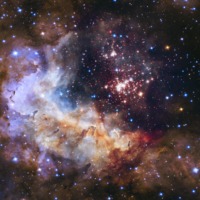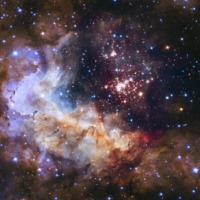Westerlund 2
Dublin Core
Title
Subject
Description
ABOUT THIS IMAGE
Celestial Fireworks in Westerlund 2
The brilliant tapestry of young stars flaring to life resemble a glittering fireworks display in this Hubble Space Telescope archival image.
The sparkling centerpiece of this fireworks show is a giant cluster of thousands of stars called Westerlund 2. The cluster resides in a raucous stellar breeding ground known as Gum 29, located 20,000 light-years away from Earth in the constellation Carina.
Hubble's Wide Field Camera 3 pierced through the dusty veil shrouding the stellar nursery in near-infrared light, giving astronomers a clear view of the nebula and the dense concentration of stars in the central cluster. The cluster measures between 6 light-years and 13 light-years across.
The giant stellar grouping is only about 2 million years old and contains some of our Milky Way galaxy's hottest, brightest, and most massive stars. Some of its heftiest stars unleash torrents of ultraviolet light and hurricane-force winds of charged particles that etch away the enveloping hydrogen gas cloud. New Hubble observations are showing that lower-mass stars near the cluster's core do not have the large, dense clouds of dust that eventually could become planets in a few million years. Hubble detected those planet-forming clouds embedded in disks encircling lower-mass stars farther away from the center.
The nebula reveals a landscape of pillars, ridges, and valleys. The pillars, composed of dense gas and thought to be incubators for new stars, are a few light-years tall and point to the central star cluster. Other dense regions surround the pillars, including reddish-brown filaments of gas and dust. The red dots scattered throughout the landscape are a rich population of newly forming stars still wrapped in their gas-and-dust cocoons. The brilliant blue stars seen throughout the image are mostly foreground stars.
The image's central region, which contains the star cluster, blends visible-light data taken by Hubble's Advanced Camera for Surveys with near-infrared exposures taken by the Wide Field Camera 3. The surrounding region is composed of visible-light observations taken by the Advanced Camera for Surveys. The red colors in the nebulosity represent hydrogen; the bluish-green hues are predominantly oxygen.
ABOUT THE OBJECT
Object Name:
Westerlund 2, Gum 29
Object Description:
Cluster and Star-forming region
Object Position:
R. A. 10h 23m 58.1s
Dec. -57° 45' 48.96"
Constellation:
Carina
Distance:
20,000 light-years (6,130 parsecs)

